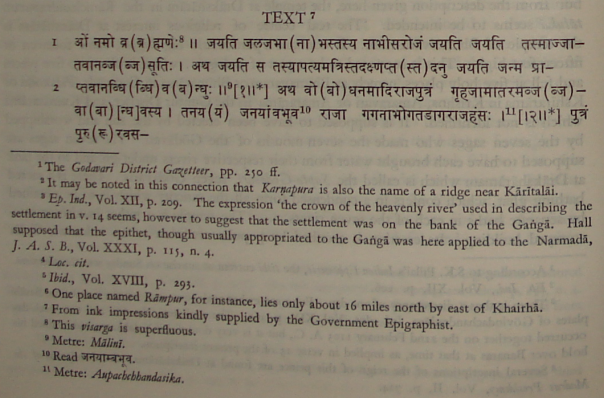|
INCRIPTIONS OF THE KALACHURIS OF TRIPURI
king.’1 The earliest inscription at Drākshārām is that of the time of Rājarāja, dated 1055
A.C. The foregoing account will show that the temple is not on the bank of the
Gōdāvarī as intimated in the present inscription; for the river flows about fourteen miles
away from it, but description given here can be understood, as has already been suggested
by Rai Bahadur Hiralal, to refer to the tank at Drākshārām, which is popularly
believed to contain the seven streams of the Gōdāvarī.
As for the localities mentioned in the present inscription, Tripurī has already
been shown to be Tewar, a village about 6 miles from Jabalpur. Karņāvatī has been
identified by Rai Bahadur Hiralal with the deserted village Karaņbēl which lies about a
mile from Tripurī2. The name has ‘a double signification, retaining the memory of the
founder in the first half and giving the distinguishing mark of the site in the second, there
being a jungle of bēl trees to supply leaves to the numerous Śiva lingas once enshrined there’3.
Kuntala has been already shown to be the country under the rule of the Later Chālukyas
of Kalyāņi. As regards Deulā-Pañchēla it appears to be a joint place-name. The
first part of it is probably represented by Deori, now a deserted village l0 miles north by
west of Khairhā, and the second by Pāchri which lies only two miles to the north of Deori.
Dēvagrāma, the headquarters of the sub-division (pattalā) in which the donated village
was situated, was identified by R.B.Hiralal with Deogavān close to Khairhā ‘where there
are a number of very old wells and water-reservoirs together with the remains of old
buildings’4. The word Vāsudēv-ōddēśē, which precedes Dēvagrāma-pattalāyām in lines
27-28 of the present grant was taken by R.B Hiralal to mean ‘in honour of Vāsudēva’.
From the context, however, it seems to denote a territorial division. Besides Yaśahkarņa
was a devotee of Mahēśvara (Śiva), not of Vāsudēva. If the grant was made in honour
of any deity it must have been Śiva. I am, therefore, inclined to take Vāsudēv-ōddēśe
of the text to mean ‘in the district of Vāsudēva’. An analogous expression Vāsudēva
khaņda-vishayē, which undoubtedly denotes a territorial division, occurs in the Ganjām
plates of Raņabhañjadēva,5 edited by R.B.Hiralal himself. There are several places6 named after Vishņu in the surrounding territory of Vindhya Pradesh.
TEXT7

Home
Page |